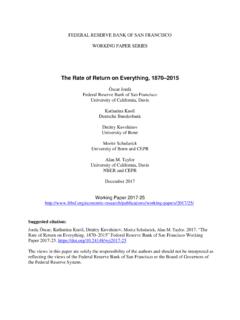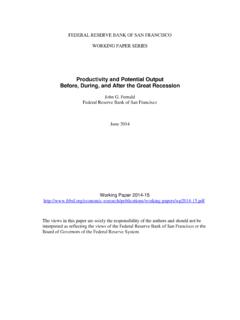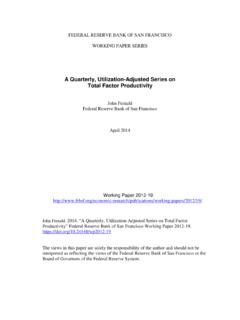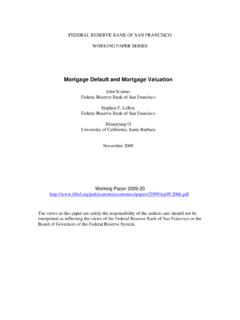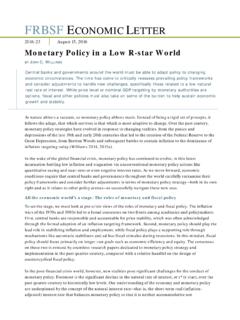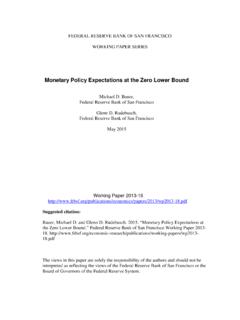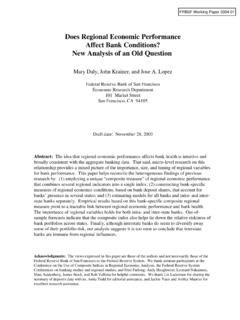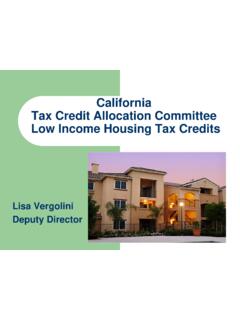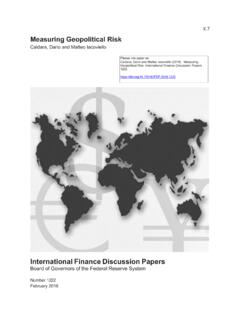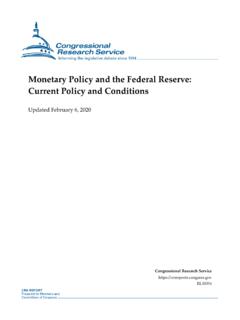Transcription of Longer-Run Economic Consequences of Pandemics
1 federal reserve BANK OF SAN FRANCISCO WORKING PAPER SERIES Longer-Run Economic Consequences of Pandemics scar Jord federal reserve Bank of San Francisco University of California, Davis Sanjay R. Singh University of California, Davis Alan M. Taylor University of California, Davis NBER and CEPR June 2020 Working Paper 2020-09 Suggested citation: Jord , scar, Sanjay R. Singh, Alan M. Taylor. 2020. Longer-Run Economic Consequences of Pandemics , federal reserve Bank of San Francisco Working Paper 2020-09. The views in this paper are solely the responsibility of the authors and should not be interpreted as reflecting the views of the federal reserve Bank of San Francisco or the Board of Governors of the federal reserve System.
2 Longer-Run Economic Consequences of Pandemics ?`Oscar Jord`a Sanjay R. Singh Alan M. Taylor June2020 AbstractWhat are the medium- to long-term effects of Pandemics ? How do they differ fromother Economic disasters? We study major Pandemics using the rates of return onassets stretching back to the14th century. Significant macroeconomic after-effects ofpandemics persist for decades, with real rates of return substantially depressed, in starkcontrast to what happens after wars. Our findings are consistent with the neoclassicalgrowth model: capital is destroyed in wars, but not in Pandemics ; Pandemics insteadmay induce relative labor scarcity and/or a shift to greater precautionary classification codes:E43, F41, I10, N10, N30, N40, : Pandemics , wars, depressions, real interest rate, natural rate, local are grateful to Robert Allen, Gregory Clark, Paul Schmelzing, and the Bank of England for makingtheir datasets publicly available.
3 All errors are ours. The views expressed herein are solely those of theauthors and do not necessarily represent the views of the federal reserve Bank of San Francisco or theFederal reserve System. federal reserve Bank of San Francisco and Department of Economics, University of California, Department of Economics, University of California, Davis Department of Economics and Graduate School of Management, University of California, Davis; NBER;and CEPR IntroductionHow should we think about the medium- to long-term macroeconomic effects of globalpandemics? This is an important question for policymakers given the massive economicfallout from the COVID-19outbreak. The first instinct is to draw from the experience ofprevious natural disasters and armed conflicts, for which the twentieth century providesample evidence.
4 That instinct turns out to be wrong. In this paper we use the history ofmajor Pandemics , major wars, and the rates of return since the14th century to shed lighton this many studies of Pandemics , analysis has understandably focused on short-termimpacts. Even then, direct measures based on data from past episodes are not generallyavailable ( , in the , Meltzer, Cox, and Fukuda,1999). An alternative would be tolook at microeconomic outcomes of a given population in episodes for which high-qualityadministrative data are available ( , in Sweden, Karlsson, Nilsson, and Pichler,2014).Absent such data, Economic historians have to use more aggregated data at the regionalor national level to study the relationship between pandemic incidence and economicoutcomes ( , the1918flu epidemic across states Brainerd and Siegler,2003; Barro,Urs ua, and Weng,2020).
5 But again, most historical studies have typically focused on oneevent in one country or region and have traced local outcomes for up to a decade at course, the most devastating pandemic of the last millennium, the Black Death, hasattracted a great deal of scholarly attention. Economists and historians debate its pivotalrole in Economic , social, and political change, particularly in Europe. Events such as thePeasants Rebellion in England feature centrally in a narrative of rising worker power, andthe data speak to an emergence of labor scarcity seen in a positive deviation in the pathof real wages. This shock left England with a25% to40% drop in labor supply, a roughly100% increase in real wages, and a decline in rates of return on land from about8% to5% (Clark,2007,2010).
6 But it is an open question how representative the macroeconomicresponses in the case of the Black Death are of large Pandemics in :Nineteen major pandemic events from the past with at least100,000estimated deathsbrtpegcbabpaplewvtBlack Death (1331 1353)Spanish flu (1918 1920)Asian flu (1957 1958)Encephalitis lethargica pandemic (1915 1926)Plague in Kingdom of Naples (1656 1658)Third cholera pandemic (1852 1860)Russian flu (1889 1890)Hong Kong flu (1968 1969)Sixth cholera pandemic (1899 1923)Plague in Spain (1596 1602)Fourth cholera pandemic (1863 1875)Swine Flu (2009)Italian plague (1629 1631)Great Northern War plague (1700 1721)Great Plague of Sevilla (1647 1652)Great Plague of London (1665 1666)Great Plague of Marseille (1720 1722)First cholera pandemic (1816 1826)Second cholera pandemic (1829 1851)
7 1001000100001000001000000 Deaths (thousands)RangeCirillo-Taleb central estimateCirillo-Taleb high-low rangeOther estimates and sourcesCirillo-Taleb central estimate(rescaled to 2020 world population)COVID-19 global deaths reach 500,000on June 28, 2020 (JHU data)Notes:The main data are taken from the recently published study of Cirillo and Taleb (2020). See the references therein. Additionalestimates of pandemic mortality are taken from: (g) George M. Gould and Walter L. & Curiosities of York: Bell; (w) Wang-Shick Virology of Human Pathogenic Viruses. Amsterdam: Academic Press. (c) ; (b)Encyclopaedia Britannica; (v) C ecile Viboud et Mortality Impact of the1957 1959 Influenza Pandemic;Journal of Infectious Diseases213(5):738 45; (r) Ravenholt and , encephalitis lethargica, (8303):860 864; (a) Alfani and Murphy (2017); (t) PaulV.
8 Targonski and Gregory A. Influenza. InInternational Encyclopedia of Public Health,2nd ed., edited by William Amsterdam: Academic Press. (p) Stanley G. History of Spain and Portugal. Madison, Wisc.: University ofWisconsin Press. (l) James Plague and The Fire. London : George Allen and Unwin. (e) Cindy The Plagueof Provence: Early Advances in the Centralization of Crisis (9). [Arcadia Collection: Disaster Histories.]Evidence: Past pandemic events and lessons for we take a macroeco-nomic view of the Consequences of Pandemics , and study the average effect of pandemicsacross all major events since the Black Death, looking at outcomes up to40years out. Inlarge scale Pandemics , effects will be felt across whole economies, or across wider regions,for two reasons: either because the infection itself is widespread, or because trade andmarket integration in capital and/or labor markets eventually propagates the economicshock across that end, our focus is on European Pandemics since macroeconomic data are onlyavailable in this region before modern times.
9 We study rates of return on assets using adataset stretching back to the14th century, focusing on19major pandemic events wheremore than100,000people died. We also look at more limited evidence on real wages. Theevents are listed in Figure1and, as is clear, the inability of researchers to precisely estimate2death tolls in past Pandemics hinders our ability to consider event scaling in what for the most famous pandemic event, the Black Death, Herlihy (1997) asserts: TheBlack Death of1348and1349, and the recurrent epidemics of the fourteenth and fifteenthcenturies, were the most devastating natural disasters ever to strike Europe. We cannot citeexact losses; there are no global figures. Our Figure1shows that numerical uncertaintyafflicts all death tolls up to, and including, the20th century.
10 The baseline range of estimatesare taken from the newly published study of Cirillo and Taleb (2020), with alternativesfrom other sources. For some Pandemics , the range of estimates varies by a factor of5or10( , The Italian Plague). Many vary by a factor of2, such as the small plagues,London, Sevilla, Marseille. Estimates for the Black Death itself range , even for as recent an event as the Hong Kong Flu of1968 69, estimates vary bya factor of4, from1to4million. For the Cholera epidemics only a single, round number isgiven in sources, suggesting a rough guess. Perhaps this should be no surprise: even nowin real time we see authorities, by accident or design, misreporting incorrect case and deathcounts for COVID-19.
